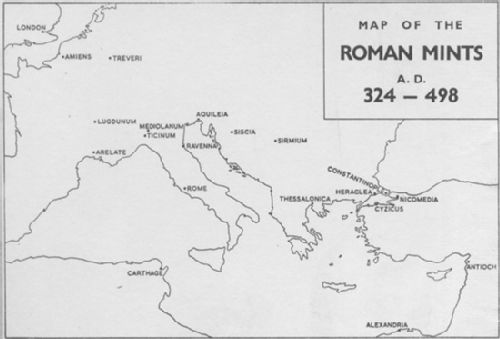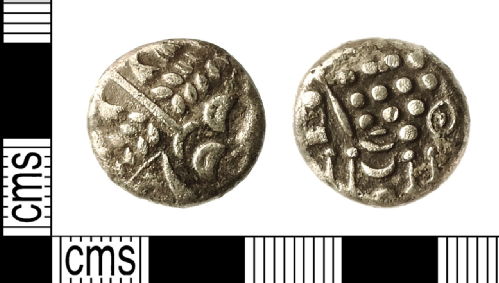Coining in Roman Britain Part 1: Before the Romans
This month the blog will run a series of posts about coinage in Britain, written by Dom Chorney. We kick the month off by looking at the coinage that existed in Britain before the Romans!
 |
|
Map showing Rome's mints in the fourth century. |
The Romans didn’t just strike coins in their capitol, far from it. In fact by the 4th Century AD over a dozen official mints operated in the provinces of the empire, producing massive numbers of coins (see map). These mints tended to stem from provincial cities who struck their own coins in earlier periods of history, such as Alexandria in Egypt. Some however, were entirely new creations, in particular the mint at Londinum, modern day London. This series of posts will provide a very brief history on the subject of coin minting in Roman Britain, from the decades following the invasion in AD 43, to so called ‘decree’ of Honorius in AD 410, the date (though somewhat unreliable) believed by many to pinpoint the end of Britain as a Roman province.
Before the Romans: Celtic Coinage
 |
|
Silver uninscribed stater struck in the south-west of Britain (50-20 BC). |
Despite the controversial use of the term ‘Celtic’, many scholars still refer to the coins minted in the last two centuries of Britain’s Iron Age as Celtic coins. The so called ‘tribes’ of Iron Age Britain struck coins, many deriving from gold staters produced in Greece by Philip II of Macedon, but with highly stylised designs. The iconography varies from region to region, but most Iron Age coins depict horses and stylized heads in a very abstract form. Through time, the coins of many Iron Age ‘tribes’ such as the Atrebates and the Catuvellauni become more Roman in style, indicating increasing contact with Rome. Some tribe’s coins show defiance, such as those minted in the South-West, where, rather than designs becoming more classical in nature, the coins become more abstract (see the coin pictured: coins like these are believed to indicate a strong refusal to adopt Roman style. Note the storngly stylised horse). Iron Age coins were minted in gold, silver and bronze, and are a complicated and highly theoretical topic in their own right. Mints of the Iceni (famously the tribe of the warrior queen, Boudicca) continued to produce coins in the years following the Roman invasion.
 This month's coin series on Roman Britain is written by Dom Chorney, a young numismatist from Glastonbury, Somerset. He studied for his undergraduate degree at Cardiff (in archaeology), and achieved a 2:1. Dom is currently studying for an MA in Ancient Visual and Material Culture at the University of Warwick, and intends to undertake a doctorate in 2015. His main areas of interest are coin use in later Roman Britain, counterfeiting in antiquity, coins as site-finds, and the coinage of the Gallic Empire.
This month's coin series on Roman Britain is written by Dom Chorney, a young numismatist from Glastonbury, Somerset. He studied for his undergraduate degree at Cardiff (in archaeology), and achieved a 2:1. Dom is currently studying for an MA in Ancient Visual and Material Culture at the University of Warwick, and intends to undertake a doctorate in 2015. His main areas of interest are coin use in later Roman Britain, counterfeiting in antiquity, coins as site-finds, and the coinage of the Gallic Empire.
Image credits: Map from Late Roman Bronze Coinage, inside cover. Coin image from the Portable Antiquities Scheme, PAS IOW-035588.
 Clare Rowan
Clare Rowan


 Loading…
Loading…
Add a comment
You are not allowed to comment on this entry as it has restricted commenting permissions.